Effective Combination of Advancing Transplantation Date with High-Yielding Cultivars for Paddy Rice Could Increase the Yield Potential Under Climate Warming in China
Abstract
1. Introduction
2. Materials and Methods
2.1. Study Sites
2.2. CERES-Rice Model
2.3. Cultivar Optimization
2.4. Transplanting Date Optimization
2.5. Rice Planting System Optimization
2.6. Adaptability Evaluation of Optimal Rice Planting System
3. Results
3.1. Model Calibration and Validation
3.2. Sensitivity of Genetic Parameters on Rice Yield
3.3. Optimal Cultivar for Current Transplanting Date
3.4. Effects of Different Transplanting Dates on Rice Phenology and Yield
3.5. Interaction of Cultivar and Transplanting Date
3.6. Impacts of Optimal Cultivar and Transplanting Date on Rice Potential Yield Under Future Climate
4. Discussion
4.1. Effects of Cultivar and Transplanting Date on Phenology and Yield of Rice
4.2. Optimal Managements for Different Rice Systems
4.3. Limitations and Suggestions
5. Conclusions
Author Contributions
Funding
Data Availability Statement
Conflicts of Interest
References
- Long, S.P.; Ainsworth, E.A.; Leakey, A.D.B.; Nosberger, J.; Ort, D.R. Food for thought: Lower-than-expected crop yield stimulation with rising CO2 concentrations. Science 2006, 312, 1918–1921. [Google Scholar] [CrossRef] [PubMed]
- Becker, M.; Clavero, R.; Khin, O.M.; Kong, S.; Maung, Z.N.; Men, P.; Pariyar, S.; Regalado, M.J.C.; Ro, S.; Win, K.K. System shift in rice: Processes and pathways of change in rice-based production systems of Southeast Asia. Agric. Syst. 2024, 217, 103917. [Google Scholar] [CrossRef]
- NBS. National Bureau of Statistics of China. 2022. Available online: https://data.stats.gov.cn/english/easyquery.htm?cn=C01 (accessed on 2 January 2025).
- FAO. World Food and Agriculture—Statistical Yearbook 2024; World Food and Agriculture: Rome, Italy, 2024. [Google Scholar] [CrossRef]
- Challinor, A.J.; Watson, J.; Lobell, D.B.; Howden, S.M.; Smith, D.R.; Chhetri, N. A meta-analysis of crop yield under climate change and adaptation. Nat. Clim. Change 2014, 4, 287–291. [Google Scholar] [CrossRef]
- Waongo, M.; Laux, P.; Kunstmann, H. Adaptation to climate change: The impacts of optimized planting dates on attainable maize yields under rainfed conditions in Burkina Faso. Agric. For. Meteorol. 2015, 205, 23–39. [Google Scholar] [CrossRef]
- Zhou, H.; Tao, F.; Chen, Y.; Yin, L.; Wang, Y.; Li, Y.; Zhang, S. Climate change reduces agricultural total factor productivity in major agricultural production areas of China even with continuously increasing agricultural inputs. Agric. For. Meteorol. 2024, 349, 109953. [Google Scholar] [CrossRef]
- Mueller, N.D.; Gerber, J.S.; Johnston, M.; Ray, D.K.; Ramankutty, N.; Foley, J.A. Closing yield gaps through nutrient and water management. Nature 2012, 490, 254–257. [Google Scholar] [CrossRef] [PubMed]
- Evans, L.T.; Fischer, R.A. Yield Potential: Its Definition, Measurement, and Significance. Crop Sci. 1999, 39, 1544–1551. [Google Scholar] [CrossRef]
- Peng, S.; Cassman, K.G.; Virmani, S.S.; Sheehy, J.; Khush, G.S. Yield Potential Trends of Tropical Rice Since the Release of IR8 and the Challenge of Increasing Rice Yield Potential. Crop Sci. 1999, 39, 1552–1559. [Google Scholar] [CrossRef]
- Lobell, D.B.; Asner, G.P. Climate and management contributions to recent trends in US agricultural yields. Science 2003, 299, 1032. [Google Scholar] [CrossRef] [PubMed]
- Peng, S.; Buresh, R.J.; Huang, J.; Zhong, X.; Zou, Y.; Yang, J.; Wang, G.; Liu, Y.; Hu, R.; Tang, Q.; et al. Improving nitrogen fertilization in rice by sitespecific N management. A review. Agron. Sustain. Dev. 2010, 30, 649–656. [Google Scholar] [CrossRef]
- Nhamo, N.; Rodenburg, J.; Zenna, N.; Makombe, G.; Luzi-Kihupi, A. Narrowing the rice yield gap in East and Southern Africa: Using and adapting existing technologies. Agric. Syst. 2014, 131, 45–55. [Google Scholar] [CrossRef]
- Mueller, N.D.; Lassaletta, L.; Runck, B.C.; Billen, G.; Garnier, J.; Gerber, J.S. Declining spatial efficiency of global cropland nitrogen allocation. Glob. Biogeochem. Cycles 2017, 31, 245–257. [Google Scholar] [CrossRef]
- Amirahmadi, E.; Moudrý, J.; Konvalina, P.; Hörtenhuber, S.J.; Ghorbani, M.; Neugschwandtner, R.W.; Jiang, Z.; Krexner, T.; Kopecký, M. Environmental Life Cycle Assessment in Organic and Conventional Rice Farming Systems: Using a Cradle to Farm Gate Approach. Sustainability 2022, 14, 15870. [Google Scholar] [CrossRef]
- Yang, X.; Chen, F.; Lin, X.; Liu, Z.; Zhang, H.; Zhao, J.; Li, K.; Ye, Q.; Li, Y.; Lv, S.; et al. Potential benefits of climate change for crop productivity in China. Agric. For. Meteorol. 2015, 208, 76–84. [Google Scholar] [CrossRef]
- He, Q.; Zhou, G. Climate-associated distribution of summer maize in China from 1961 to 2010. Agric. Ecosyst. Environ. 2016, 232, 326–335. [Google Scholar] [CrossRef]
- Peng, S.; Khush, G.S.; Virk, P.; Tang, Q.; Zou, Y. Progress in ideotype breeding to increase rice yield potential. Field Crops Res. 2008, 108, 32–38. [Google Scholar] [CrossRef]
- He, Q.; Zhou, G.; Liu, J. Progress in Studies of Climatic Suitability of Crop Quality and Resistance Mechanisms in the Context of Climate Warming. Agronomy 2022, 12, 3183. [Google Scholar] [CrossRef]
- Yu, Y.; Huang, Y.; Zhang, W. Changes in rice yields in China since 1980 associated with cultivar improvement, climate and crop management. Field Crops Res. 2012, 136, 65–75. [Google Scholar] [CrossRef]
- Xiao, D.; Tao, F. Contributions of cultivars, management and climate change to winter wheat yield in the North China Plain in the past three decades. Eur. J. Agron. 2014, 52, 112–122. [Google Scholar] [CrossRef]
- Bai, H.; Tao, F.; Xiao, D.; Liu, F.; Zhang, H. Attribution of yield change for rice-wheat rotation system in China to climate change, cultivars and agronomic management in the past three decades. Clim. Change 2015, 135, 539–553. [Google Scholar] [CrossRef]
- Hu, X.; Huang, Y.; Sun, W.; Yu, L. Shifts in cultivar and planting date have regulated rice growth duration under climate warming in China since the early 1980s. Agric. For. Meteorol. 2017, 247, 34–41. [Google Scholar] [CrossRef]
- Bai, H.; Tao, F. Sustainable intensification options to improve yield potential and eco-efficiency for rice-wheat rotation system in China. Field Crops Res. 2017, 211, 89–105. [Google Scholar] [CrossRef]
- Zhao, H.; Fu, Y.H.; Wang, X.; Zhao, C.; Zeng, Z.; Piao, S. Timing of rice maturity in China is affected more by transplanting date than by climate change. Agric. For. Meteorol. 2016, 216, 215–220. [Google Scholar] [CrossRef]
- Wang, X.; Ciais, P.; Li, L.; Ruget, F.; Vuichard, N.; Viovy, N.; Zhou, F.; Chang, J.; Wu, X.; Zhao, H.; et al. Management outweighs climate change on affecting length of rice growing period for early rice and single rice in China during 1991–2012. Agric. For. Meteorol. 2017, 233, 1–11. [Google Scholar] [CrossRef]
- Chen, X.; Chen, F.; Chen, Y.; Gao, Q.; Yang, X.; Yuan, L.; Zhang, F.; Mi, G. Modern maize hybrids in Northeast China exhibit increased yield potential and resource use efficiency despite adverse climate change. Glob. Change Biol. 2013, 19, 923–936. [Google Scholar] [CrossRef] [PubMed]
- Jalota, S.K.; Singh, K.B.; Chahal, G.B.S.; Gupta, R.K.; Chakraborty, S.; Sood, A.; Ray, S.S.; Panigrahy, S. Integrated effect of transplanting date, cultivar and irrigation on yield, water saving and water productivity of rice (Oryza sativa L.) in Indian Punjab: Field and simulation study. Agric. Water Manag. 2009, 96, 1096–1104. [Google Scholar] [CrossRef]
- Grassini, P.; Yang, H.; Cassman, K.G. Limits to maize productivity in Western Corn-Belt: A simulation analysis for fully irrigated and rainfed conditions. Agric. For. Meteorol. 2009, 149, 1254–1265. [Google Scholar] [CrossRef]
- Li, Y.; Tao, F. Rice yield response to climate variability diverges strongly among climate zones across China and is sensitive to trait variation. Field Crops Res. 2023, 301, 109034. [Google Scholar] [CrossRef]
- Jones, J.W.; Hoogenboom, G.; Porter, C.H.; Boote, K.J.; Batchelor, W.D.; Hunt, L.A.; Wilkens, P.W.; Singh, U.; Gijsman, A.J.; Ritchie, J.T. The DSSAT Cropping System Model. Eur. J. Agron. 2003, 18, 235–265. [Google Scholar] [CrossRef]
- Saseendran, S.A.; Hubbard, K.G.; Singh, K.K.; Mendiratta, N.; Rathore, L.S.; Singh, S.V. Optimum Transplanting Dates for Rice in Kerala, India, Determined Using Both CERES v3.0 and ClimProb. Agron. J. 1998, 90, 185–190. [Google Scholar] [CrossRef]
- Timsina, J.; Humphreys, E. Performance of CERES-Rice and CERES-Wheat models in rice–wheat systems: A review. Agric. Syst. 2006, 90, 5–31. [Google Scholar] [CrossRef]
- Angstrom, A. Solar and terrestrial radiation. Report to the international commission for solar research on actinometric investigations of solar and atmospheric radiation. Quart. J. R. Meteorol. Soc. 1924, 50, 121–126. [Google Scholar] [CrossRef]
- Prescott, J.A. Evaporation from a Water Surface in Relation to Solar Radiation. Trans. Roy. Soc. S. Aust. 1940, 64, 114–118. [Google Scholar]
- van Vuuren, D.P.; Edmonds, J.; Kainuma, M.; Riahi, K.; Thomson, A.; Hibbard, K.; Hurtt, G.C.; Kram, T.; Krey, V.; Lamarque, J.-F.; et al. The representative concentration pathways: An overview. Clim. Change 2011, 109, 5–31. [Google Scholar] [CrossRef]
- Gourdji, S.M.; Sibley, A.M.; Lobell, D.B. Global crop exposure to critical high temperatures in the reproductive period: Historical trends and future projections. Environ. Res. Lett. 2013, 8, 024041. [Google Scholar] [CrossRef]
- Shi, X.Z.; Yu, D.S.; Warner, E.D.; Pan, X.Z.; Petersen, G.W.; Gong, Z.G.; Weindorf, D.C. Soil Database of 1:1,000,000 Digital Soil Survey and Reference System of the Chinese Genetic Soil Classification System. Soil Surv. Horiz. 2004, 45, 129–136. [Google Scholar] [CrossRef]
- FAO; IIASA; ISRIC; ISS-CAS; JRC. Harmonized World Soil Database (Version 1.2); FAO: Rome, Italy; IIASA: Laxenburg, Austria, 2012. [Google Scholar]
- He, J.; Jones, J.W.; Graham, W.D.; Dukes, M.D. Influence of likelihood function choice for estimating crop model parameters using the generalized likelihood uncertainty estimation method. Agric. Syst. 2010, 103, 256–264. [Google Scholar] [CrossRef]
- Pal, R.; Mahajan, G.; Sardana, V.; Chauhan, B.S. Impact of sowing date on yield, dry matter and nitrogen accumulation, and nitrogen translocation in dry-seeded rice in North-West India. Field Crops Res. 2017, 206, 138–148. [Google Scholar] [CrossRef]
- Zhang, H.; Tao, F.; Xiao, D.; Shi, W.; Liu, F.; Zhang, S.; Liu, Y.; Wang, M.; Bai, H. Contributions of climate, varieties, and agronomic management to rice yield change in the past three decades in China. Front. Earth Sci. 2016, 10, 315–327. [Google Scholar] [CrossRef]
- Tao, F.; Zhang, Z.; Shi, W.; Liu, Y.; Xiao, D.; Zhang, S.; Zhu, Z.; Wang, M.; Liu, F. Single rice growth period was prolonged by cultivars shifts, but yield was damaged by climate change during 1981–2009 in China, and late rice was just opposite. Glob. Change Biol. 2013, 19, 3200–3209. [Google Scholar] [CrossRef]
- Liu, Y.; Zhang, H.; Li, G.; Sun, X.; Wang, M. A comprehensive method to increase yield and narrow the yield gap of winter wheat for sustainable intensification. J. Sci. Food Agric. 2022, 102, 4238–4249. [Google Scholar] [CrossRef]
- Liu, L.; Wang, E.; Zhu, Y.; Tang, L.; Cao, W. Quantifying three-decade changes of single rice cultivars in China using crop modeling. Field Crops Res. 2013, 149, 84–94. [Google Scholar] [CrossRef]

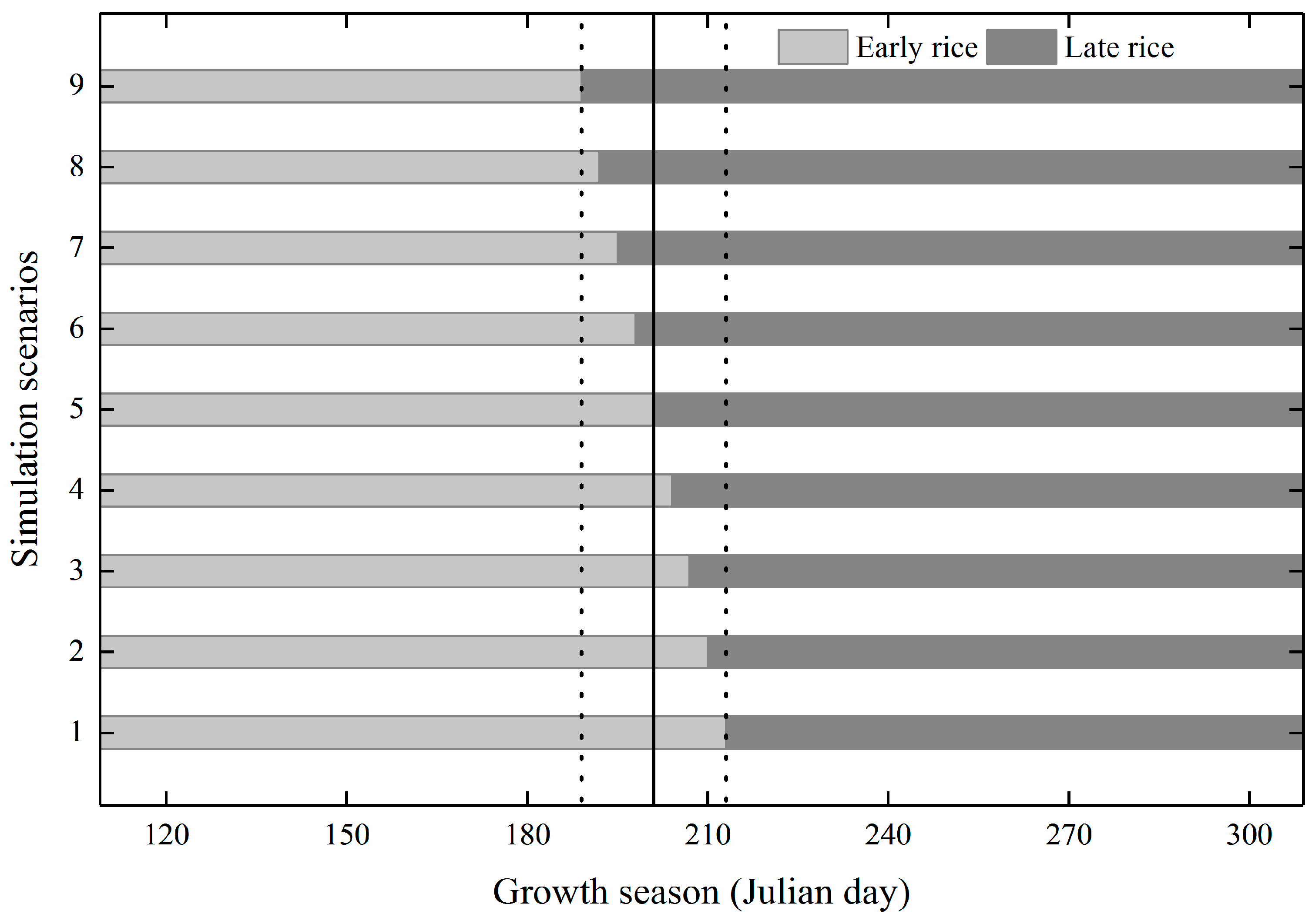
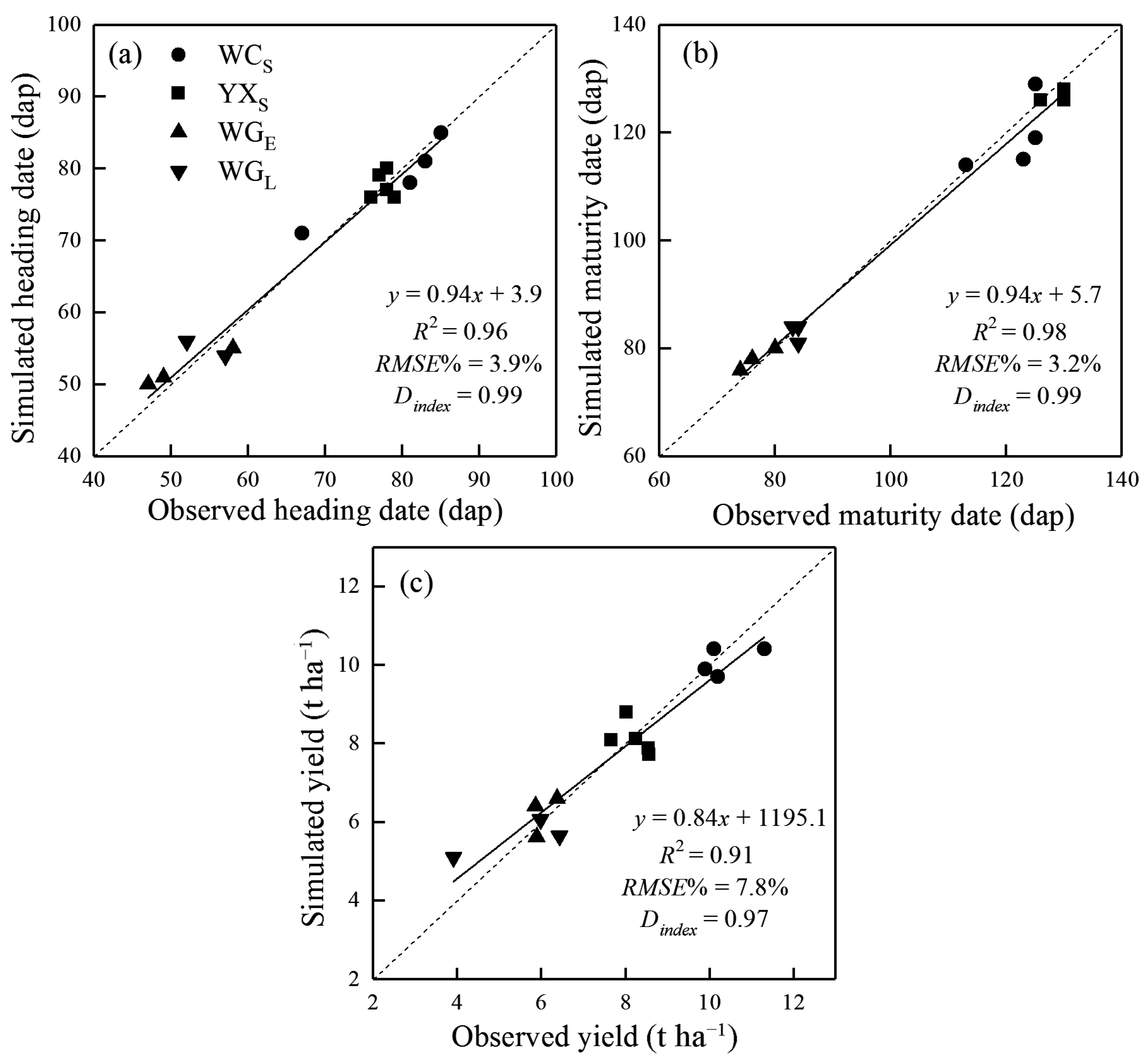

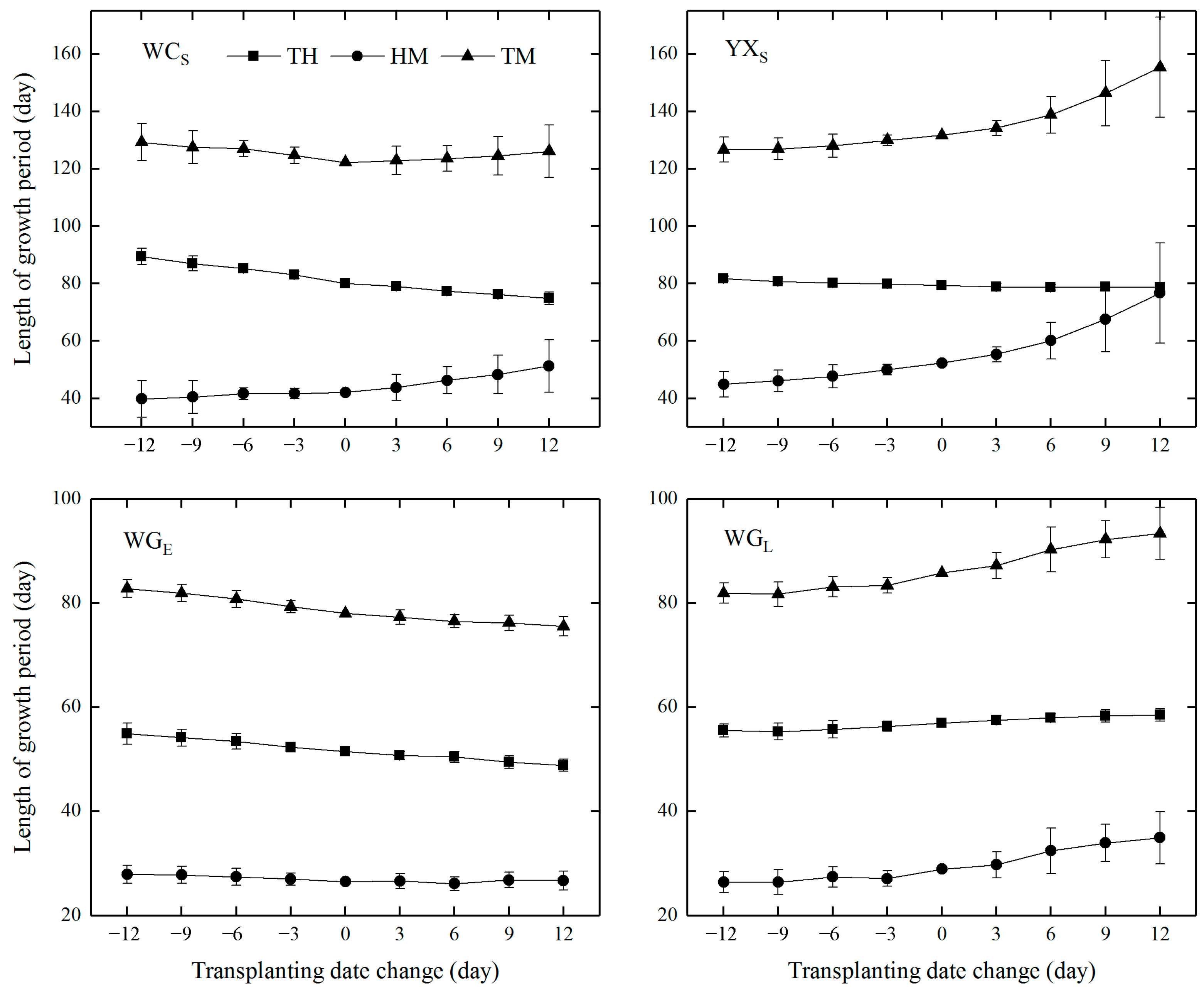
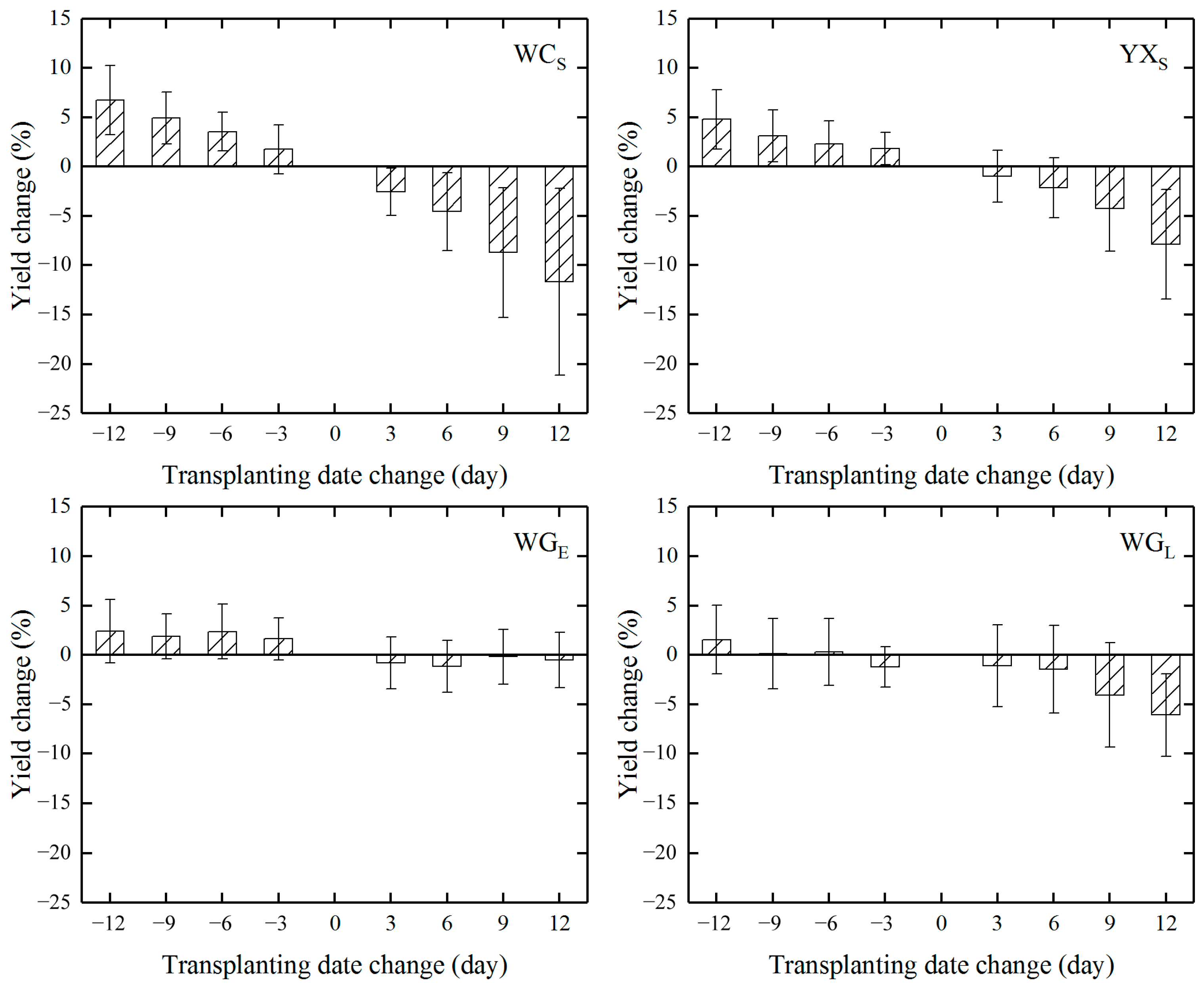
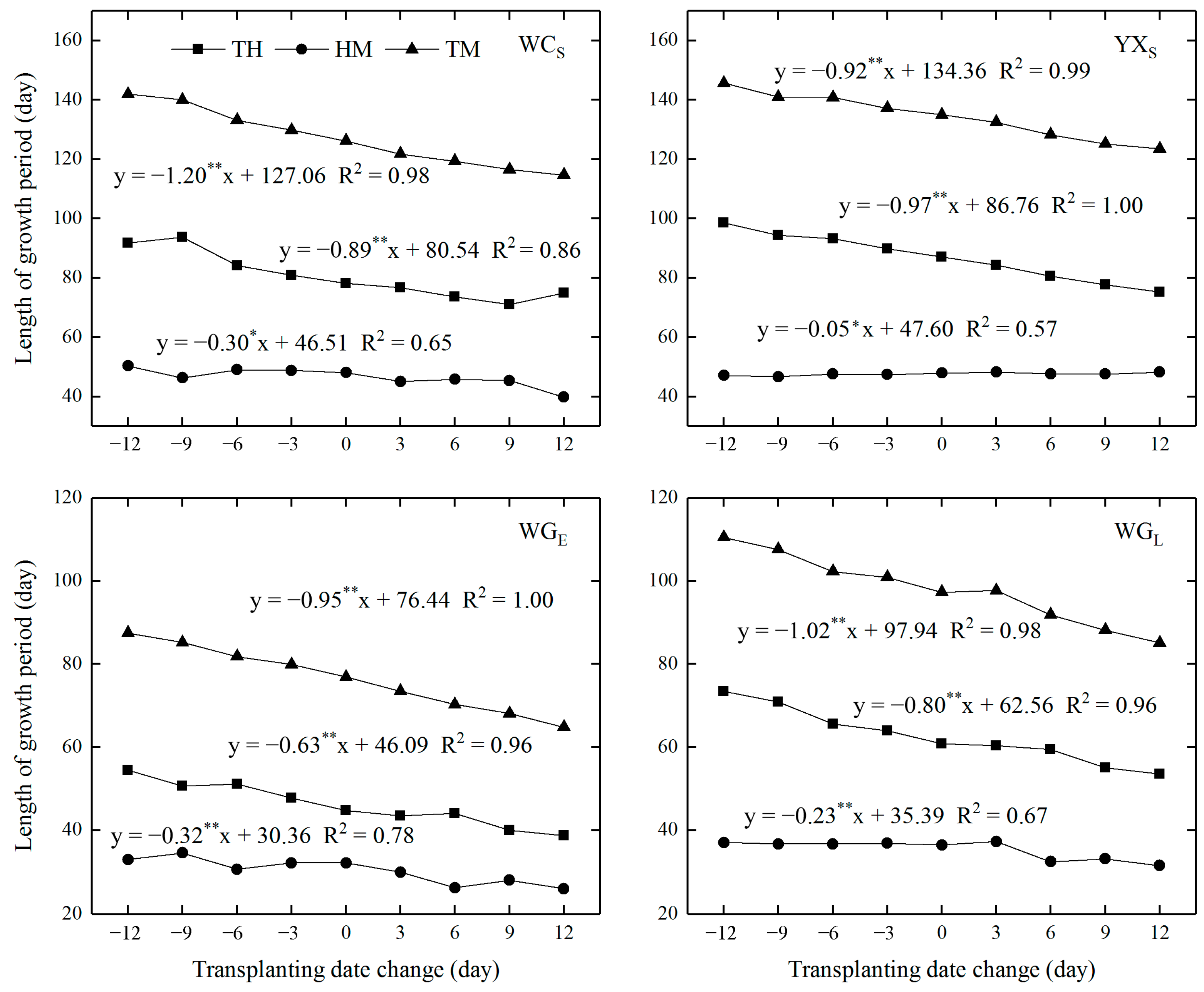
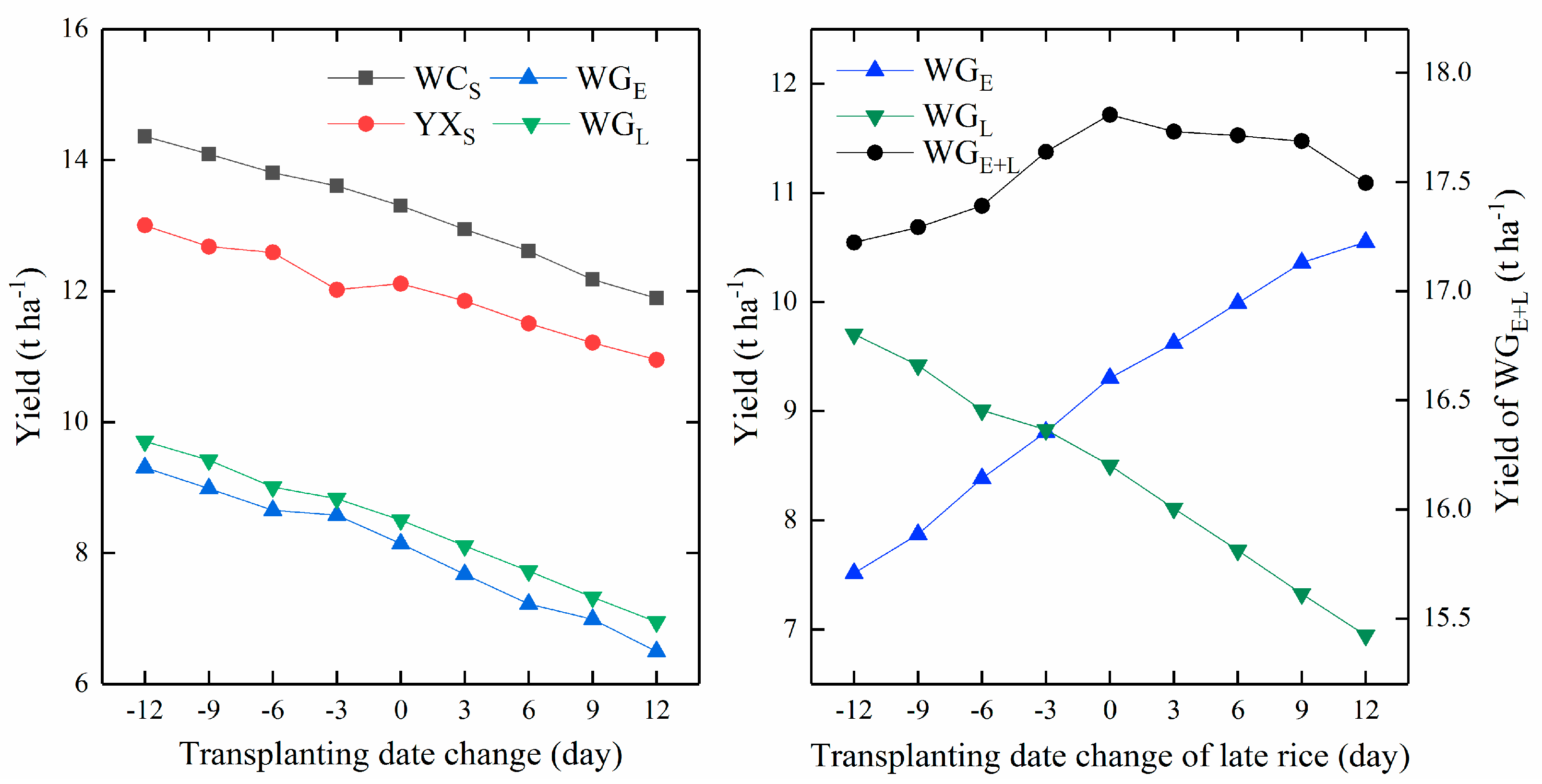
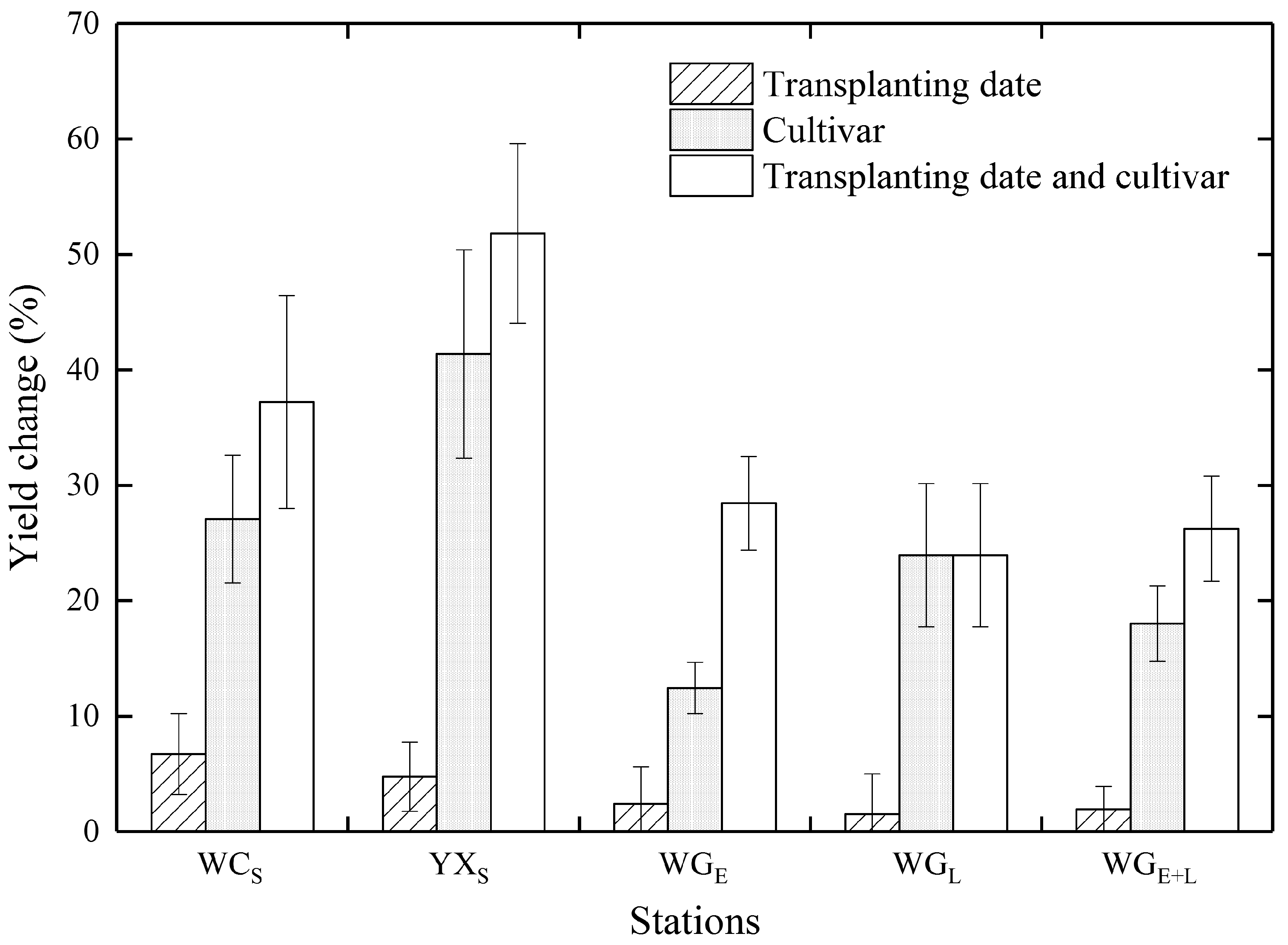

| Stations | WCS | YXS | WGE | WGL |
|---|---|---|---|---|
| Latitude (°N) | 44.90 | 31.33 | 26.73 | 26.73 |
| Longitude (°E) | 127.10 | 119.82 | 110.63 | 110.63 |
| Altitude (m) | 194.6 | 16.4 | 341.0 | 341.0 |
| Cropping system | Single rice | Rice–wheat | Double rice | Double rice |
| Cultivar | WYD4 | WYJ | TY706 | YX88 |
| Period of date | 2007–2012 | 2004–2010 | 2007–2010 | 2007–2010 |
| Planting date (m/d 1) | 4/13 | 5/27 | 3/28 | 6/22 |
| Transplanting date (m/d) | 5/16 | 6/17 | 5/1 | 7/20 |
| Soil texture | Loam | Clay loam | Sandy loam | Sandy loam |
| Total N (%) | 0.24 | 0.16 | 0.18 | 0.18 |
| Soil organic carbon (%) | 0.82 | 1.12 | 1.24 | 1.24 |
| Genetic Parameters | Definition (Units) | Impact Phase |
|---|---|---|
| P1 | Time period for basic vegetative phase (growing degree days [GDD] in °C above base 9 °C) | Phenology |
| P2R | Photoperiod sensitivity parameter (GDD in °C) | Phenology |
| P2O | Critical photoperiod (hours) | Phenology |
| P5 | Time period for grain-filling phase (GDD in °C above base 9 °C) | Phenology |
| G1 | Potential spikelet number coefficient | Yield |
| G2 | Potential single grain weight (g) | Yield |
| G3 | Tillering coefficient | Yield |
| G4 | Temperature tolerance coefficient | Yield |
| ID | GCM | Institution | Country |
|---|---|---|---|
| 1 | GFDL-ESM2M | NOAA Geophysical Fluid Dynamics Laboratory | USA |
| 2 | HadGEM2-ES | Met Office Hadley Centre | UK |
| 3 | IPSL-CM5A-LR | Institute Pierre-Simon Laplace | France |
| 4 | MIROC-ESM-CHEM | Japan Agency for Marine-Earth Science and Technology, Atmosphere and Ocean Research Institute and National Institute for Environmental Studies | Japan |
| 5 | NorESM1-M | Norwegian Climate Center | Norway |
| Periods | RCP 2.6 | RCP 4.5 | RCP 6.0 | RCP 8.5 |
|---|---|---|---|---|
| Base period | 360 | 360 | 360 | 360 |
| 2030s | 429 | 434 | 428 | 448 |
| 2060s | 441 | 507 | 510 | 602 |
| 2090s | 426 | 534 | 633 | 841 |
| Stations | P1 | P2R | P5 | P2O | T-H | H-M | T-M | Yield | Yield Change (%) |
|---|---|---|---|---|---|---|---|---|---|
| WCS | 246.7 | 47.4 | 328.9 | 12.1 | 80 | 42 | 122 | 10,469 | |
| 296.0 | 37.9 | 394.7 | 13.3 | 78 | 48 | 126 | 13,303 | 27.1 | |
| YXS | 653.1 | 107.7 | 583.0 | 11.7 | 79 | 52 | 132 | 8562 | |
| 522.5 | 107.7 | 466.4 | 11.7 | 87 | 48 | 135 | 12,112 | 41.4 | |
| WGE | 330.4 | 41.9 | 349.4 | 11.3 | 52 | 27 | 78 | 7245 | |
| 264.3 | 37.7 | 384.3 | 11.3 | 45 | 32 | 77 | 8144 | 12.4 | |
| WGL | 331.1 | 90.6 | 232.9 | 11.9 | 57 | 29 | 86 | 6866 | |
| 298.0 | 81.5 | 279.5 | 11.9 | 61 | 37 | 97 | 8504 | 23.9 |
Disclaimer/Publisher’s Note: The statements, opinions and data contained in all publications are solely those of the individual author(s) and contributor(s) and not of MDPI and/or the editor(s). MDPI and/or the editor(s) disclaim responsibility for any injury to people or property resulting from any ideas, methods, instructions or products referred to in the content. |
© 2025 by the authors. Licensee MDPI, Basel, Switzerland. This article is an open access article distributed under the terms and conditions of the Creative Commons Attribution (CC BY) license (https://creativecommons.org/licenses/by/4.0/).
Share and Cite
Zhang, H.; Zhou, G.; He, Q. Effective Combination of Advancing Transplantation Date with High-Yielding Cultivars for Paddy Rice Could Increase the Yield Potential Under Climate Warming in China. Agronomy 2025, 15, 119. https://doi.org/10.3390/agronomy15010119
Zhang H, Zhou G, He Q. Effective Combination of Advancing Transplantation Date with High-Yielding Cultivars for Paddy Rice Could Increase the Yield Potential Under Climate Warming in China. Agronomy. 2025; 15(1):119. https://doi.org/10.3390/agronomy15010119
Chicago/Turabian StyleZhang, He, Guangsheng Zhou, and Qijin He. 2025. "Effective Combination of Advancing Transplantation Date with High-Yielding Cultivars for Paddy Rice Could Increase the Yield Potential Under Climate Warming in China" Agronomy 15, no. 1: 119. https://doi.org/10.3390/agronomy15010119
APA StyleZhang, H., Zhou, G., & He, Q. (2025). Effective Combination of Advancing Transplantation Date with High-Yielding Cultivars for Paddy Rice Could Increase the Yield Potential Under Climate Warming in China. Agronomy, 15(1), 119. https://doi.org/10.3390/agronomy15010119








